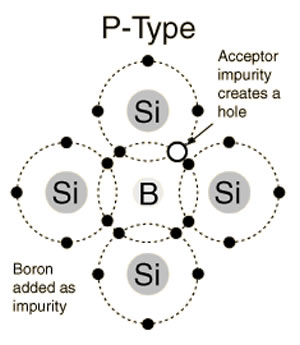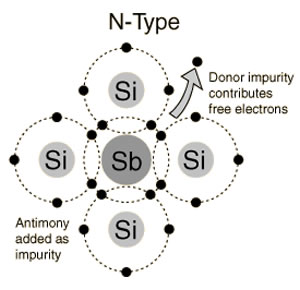Difference between P Type and N Type Semiconductor
Key Difference: The P Type and N Type are two different types of semiconductors. The P Type carries a positive charge, while the N type carries a negative charge. The charges depend on the hole concentration and the electron concentration. The P type semiconductor has a larger hole concentration, which results in the positive charge. Similarly, the N type has a larger electron concentration than the hole concentration, which results in a negative charge.
 The P Type and N Type are two different types of semiconductors; specifically they are types of extrinsic semiconductors. Semiconductors come in two primary types: intrinsic and extrinsic. Intrinsic semiconductors are semiconductors that are pure, what that means is that they don’t have any doping agents added, whereas the extrinsic semiconductors do.
The P Type and N Type are two different types of semiconductors; specifically they are types of extrinsic semiconductors. Semiconductors come in two primary types: intrinsic and extrinsic. Intrinsic semiconductors are semiconductors that are pure, what that means is that they don’t have any doping agents added, whereas the extrinsic semiconductors do.
The adding of the doping agents changes the electron and hole carrier concentrations of the semiconductor at thermal equilibrium. Thermal equilibrium is the temperature at which two adjacent substances exchange no heat energy. Basically, it allows one to manipulate the semiconductor to lower its resistance.
Extrinsic semiconductors have very common uses; primarily they are used as components in electrical devices where they provide high electrical resistance. Extrinsic semiconductors are essentially divided into two types: P Type and N Type.
They are named as such due to the charge that they carry. The P Type carries a positive charge, while the N type carries a negative charge. The charges depend on the hole concentration and the electron concentration. The P type semiconductor has a larger hole concentration, which results in the positive charge. Similarly, the N type has a larger electron concentration than the hole concentration, which results in a negative charge.

Some of the other differences between P Type and N Type Semiconductors include the fact that P Type semiconductors are created by doping an intrinsic semiconductor with acceptor impurities, whereas the n type is created by doping an intrinsic semiconductor with donor impurities. The most common types of dopant for P type is boron, aluminum or gallium; whereas the most common type of dopant for N type is phosphorus, antimony and arsenic.
The p-type semiconductors have a larger hole concentration than electron concentration, whereas the n-type semiconductors have a larger electron concentration than hole concentration. Additionally, in an n-type semiconductor, the Fermi level is greater than that of the intrinsic semiconductor. It also lies closer to the conduction band than the valence band. In the p-type semiconductor, on the other hand, the Fermi level is below the intrinsic Fermi level and it lies closer to the valence band than the conduction band.
Comparison between P Type and N Type Semiconductor:
|
|
P Type |
N Type |
|
Type of |
Extrinsic semiconductor |
Extrinsic semiconductor |
|
Description |
A type of extrinsic semiconductor that carries a positive charge and has an improved conductivity. |
A type of extrinsic semiconductor that carries a negative charge and has an improved conductivity. |
|
Hole concentration |
Larger hole concentration |
Less hole concentration |
|
Electron concentration |
Less electron concentration |
Larger electron concentration |
|
Charge |
Positive charge of the hole |
Negative charge of the electron |
|
Carriers |
Holes are the majority carriers and electrons are the minority carriers |
Electrons are the majority carriers and holes are the minority carriers |
|
Creation |
Created by doping an intrinsic semiconductor with acceptor impurities |
Created by doping an intrinsic semiconductor with donor impurities |
|
Dopant |
Common p-type dopant for silicon is boron. Others include aluminum or gallium. |
Common dopant for n-type silicon is phosphorus. Others include antimony and arsenic. |
|
Effect of doping |
Acceptor impurity creates a hole. |
Donor impurities contributes free electrons |
|
Contains |
Trivalent impurities |
Pentavalent impurities |
|
Fermi level |
Fermi level is below the intrinsic Fermi level and lies closer to the valence band than the conduction band |
Fermi level is greater than that of the intrinsic semiconductor and lies closer to the conduction band than the valence band |
Reference: Wikipedia (Semiconductor and Extrinsic Semiconductor), Gitam, Hyper Physics Image Courtesy:hyperphysics.phy-astr.gsu.edu









Comments
anonymous
Thu, 01/11/2018 - 13:30
Sospeter
Mon, 07/31/2017 - 15:34
Thank you for pointing that out. It has been fixed.
dbadmin
Sat, 08/05/2017 - 15:13
Add new comment